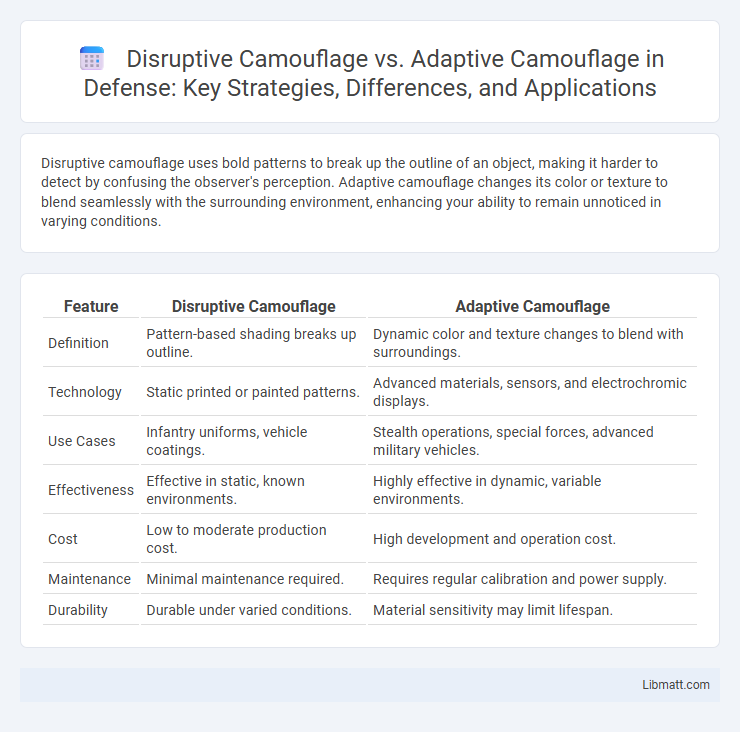Disruptive camouflage uses bold patterns to break up the outline of an object, making it harder to detect by confusing the observer's perception. Adaptive camouflage changes its color or texture to blend seamlessly with the surrounding environment, enhancing your ability to remain unnoticed in varying conditions.
Table of Comparison
| Feature | Disruptive Camouflage | Adaptive Camouflage |
|---|---|---|
| Definition | Pattern-based shading breaks up outline. | Dynamic color and texture changes to blend with surroundings. |
| Technology | Static printed or painted patterns. | Advanced materials, sensors, and electrochromic displays. |
| Use Cases | Infantry uniforms, vehicle coatings. | Stealth operations, special forces, advanced military vehicles. |
| Effectiveness | Effective in static, known environments. | Highly effective in dynamic, variable environments. |
| Cost | Low to moderate production cost. | High development and operation cost. |
| Maintenance | Minimal maintenance required. | Requires regular calibration and power supply. |
| Durability | Durable under varied conditions. | Material sensitivity may limit lifespan. |
Introduction to Camouflage Strategies
Disruptive camouflage breaks up the outline of an object with bold, contrasting patterns that confuse the observer by obscuring shape and edges, enhancing concealment in diverse environments. Adaptive camouflage dynamically changes color, pattern, or texture in response to environmental cues, allowing organisms or technology to blend seamlessly with varying surroundings. These strategies optimize survival and operational effectiveness by either misleading perception through contrast or matching background characteristics in real-time.
Defining Disruptive Camouflage
Disruptive camouflage uses high-contrast patterns to break up the outline of an object, making it harder for predators or observers to detect its true shape. Unlike adaptive camouflage, which changes color or texture to blend with the environment, disruptive camouflage relies on bold shapes and color contrasts to confuse the visual processing of your target. This technique is commonly employed in military uniforms and animal markings to enhance concealment.
Understanding Adaptive Camouflage
Adaptive camouflage uses advanced materials and sensors to alter colors and patterns in real-time, blending seamlessly with the surrounding environment. Unlike disruptive camouflage, which relies on fixed patterns to break up outlines, adaptive systems respond dynamically to changes in lighting and background. Your ability to remain undetected increases significantly with adaptive camouflage, making it ideal for complex and variable environments.
Key Differences Between Disruptive and Adaptive Camouflage
Disruptive camouflage uses high-contrast patterns to break up the outline of an object or animal, making it harder for predators or observers to detect its shape. Adaptive camouflage changes color or pattern in real-time to match the surrounding environment, enhancing concealment in diverse settings. Understanding these key differences helps you choose the right camouflage strategy for specific environments or applications.
Mechanisms Behind Disruptive Camouflage
Disruptive camouflage employs high-contrast patterns and bold shapes that break up the outline of an organism, creating false edges and confusing predators by obscuring the true body shape. This mechanism relies on contrasting colors and irregular markings strategically positioned to interfere with the perception of contours, effectively masking the organism's recognizable form. Unlike adaptive camouflage, which changes in response to the environment, disruptive camouflage uses static patterning to achieve concealment through visual deception.
How Adaptive Camouflage Functions in Nature
Adaptive camouflage functions in nature by enabling organisms to dynamically change their skin color, pattern, or texture to blend seamlessly with their surroundings, often through specialized cells called chromatophores. This ability allows species like cuttlefish, octopuses, and certain reptiles to avoid predators and ambush prey more effectively. Your understanding of adaptive camouflage highlights how evolution fine-tunes survival strategies by integrating sensory input with rapid physiological responses.
Real-World Examples of Disruptive Camouflage
Disruptive camouflage uses bold patterns and contrasting colors to break up the outline of an object or animal, making it harder to detect in complex environments. Real-world examples include the jagged black and white stripes of a zebra, which confuse predators by obscuring the animal's true shape, and the mottled, irregular patches of the cuttlefish that blend seamlessly into rocky seabeds. Understanding how these patterns work can enhance Your appreciation of natural survival strategies and inspire innovations in visual concealment technology.
Notable Cases of Adaptive Camouflage
Notable cases of adaptive camouflage include the cuttlefish and chameleon, which can rapidly change their skin color and texture to blend seamlessly with varying environments. This biological ability enhances survival by enabling dynamic concealment from predators and prey, unlike disruptive camouflage that relies on static patterns to break up an object's outline. Your understanding of adaptive camouflage highlights how advanced sensory and neural control enable these animals to respond instantly to environmental changes.
Evolutionary Advantages of Each Camouflage Type
Disruptive camouflage confers evolutionary advantages by breaking up the outline of an organism, making it difficult for predators to detect and recognize its shape, thus enhancing survival in habitats with complex backgrounds. Adaptive camouflage offers superior evolutionary benefits by allowing organisms to change their colors or patterns dynamically in response to environmental shifts, increasing concealment across varying habitats and conditions. The combination of these strategies directly influences predator-prey interactions by improving evasion capabilities and supporting reproductive success.
Applications and Future Directions in Camouflage Research
Disruptive camouflage is commonly applied in military uniforms and vehicle designs to break up outlines and hinder enemy detection, while adaptive camouflage is increasingly used in advanced military technology and wildlife research for real-time environmental blending. Future directions in camouflage research focus on integrating smart materials and AI to create dynamic, responsive surfaces that enhance concealment across diverse environments. Your ability to leverage these innovations could revolutionize not only defense strategies but also civilian uses such as fashion and architecture.
Disruptive camouflage vs Adaptive camouflage Infographic

 libmatt.com
libmatt.com